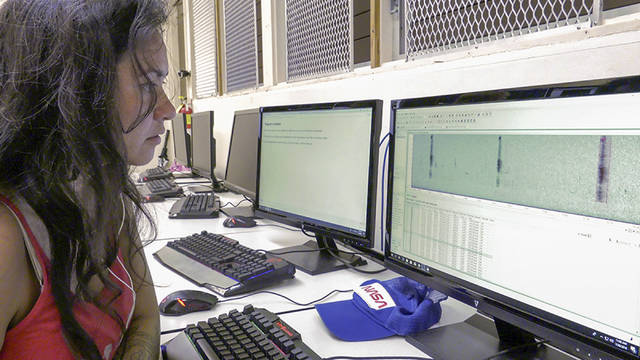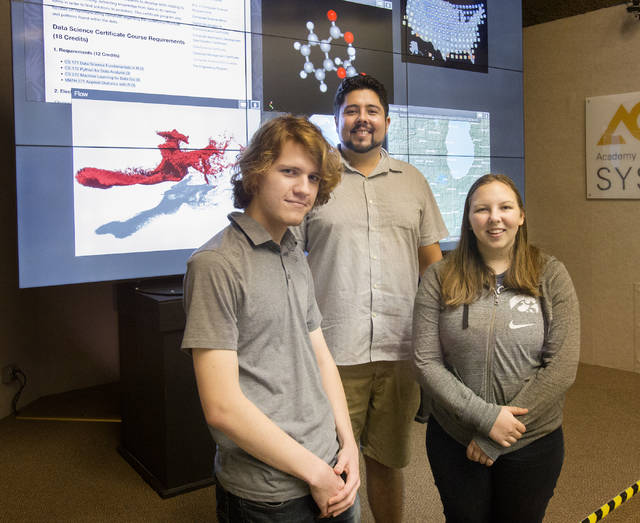The University of Hawaii at Hilo is offering for the first time this fall a certificate program in data science.
The program is four courses geared toward giving students data science skills “that will flag to future employers that they have (these) computational and statistical tools to be able to solve industry problems more quickly and more efficiently and more intelligently,” data science program director and associate professor of mathematics Roberto Pelayo said.
The hope, though, is to develop a full bachelor’s of science degree program in data science in about three years, he said.
While it’s difficult to build out a bachelor of science program, Pelayo said there’s “a lot of enthusiasm by the students and also by the faculty and administrators, so we’re all pretty confident in (that) the bachelor of science is going to be in place in about three years or so.”
According to Pelayo, UH-Hilo’s data science program started as a “statewide need for a skill set that is currently not present at Hawaii universities, which is being able to solve and tackle complicated computational problems that usually involve large data sets. So that’s really where a lot of data science got its birth. Now that data is so easy to obtain, we have a lot of it and we want to make the best decisions possible using that data.”
More traditional stats and computer algorithms can’t handle it, he said.
“So we need to be able to take older computer programs and statistical thinking and merge them together in order to be able to actually handle these very complicated data sets,” said Pelayo. “They’re large, they’re messy data sets a lot of time.”
According to Pelayo, data can come in “a variety of flavors,” like home prices or, in a more complex example, video or audio files where people may want to detect certain elements, but where there’s too much for a human to watch or listen.
“So they need to train a computer program in order to do that,” Pelayo said. “That’s part of data science, taking just large and complicated data, audio data, spatial data, scientific data that no one person can by themselves actually handle, and make sense of it and make predictions and use their analysis to actually inform stakeholders and policy makers about what to do.”
Data science is an in-demand career field, he said.
“There is not yet a robust program here in the state of Hawaii, so that’s going to be the first one inside of the UH system that we’re building.”
Students are already putting their new data science skills to use.
Micah Marshall, 19, a mathematics major from Pahoa, worked on a project this summer using recordings to detect when a certain species of bird gives its bird song.
The data, which came from recording devices put in the forest, was converted into a spectrogram, or a visual representation of a sound wave, and then an image recognition program was used to recognize the calls and songs of the puaiohi.
“You can tell, though, the kind of data he’s talking about is just, like, huge and complicated,” Pelayo said. “It’s not just a whole bunch of numbers, but it’s actually an audio file that they turn into a picture file that they need to train a computer to be able to scan and look at and intelligently pick out when they have a bird call and when they don’t, or when they have a helicopter or rain.”
Emily Risley, 19, of Hilo, is a computer science major who worked in Iowa over the summer working on a program in biostatistics, researching suicide rates and how they correlate with a number of factors.
She’s also currently working on a project looking at chlorine levels in well water on the Big Island.
“But that’s the point,” Pelayo said. “It doesn’t really matter what you’re studying, that these tools and techniques are very broadly applicable.”
Risley said she wants a career in data science and to “not just use it in whatever field I end up in.”
“I want to do everything and I think it’s a really good program to want to do everything because you can do pretty much everything with it,” she said.
Marshall plans to go into either statistics or economics, “and those are by definitions fields that make heavy use of large amounts of information to answer question and learn about big-picture scenarios, so it’s very, very applicable to that sort of thing.”
Data science can cross disciplines and Pelayo said he likes that the budding program is “building faculty capacity” in multiple departments and colleges.
According to Pelayo, three new faculty members have been hired as part of the data science program and the university is in the process of hiring a fourth.
John Burns, who was hired to be a professor in the Marine Science Department as well as the new data science program, teaches classes and conducts research as part of his role in the data science program.
“I am very excited to teach students how to utilize cutting-edge data science tools through classes, internships and volunteer research opportunities,” he said. “My goal is to provide them with training that will enhance their skillsets and help them obtain jobs as professional scientists.
For Burns, data science tools are a critical component of his research.
“I use various innovative technologies, such as 3-D mapping, to improve our ability to characterize how coral reefs respond to changing environmental conditions,” he said. “Integrating new technologies into our research vastly improves our capability to study and protect these valuable marine ecosystems.”
“It makes me tremendously proud that UH-Hilo is at the forefront of this, that we are the only campus in the UH system that is currently seeking a bachelor of science in data science,” Pelayo said.
For more information about the program, visit hilo.hawaii.edu/catalog/data-science-cert.
Email Stephanie Salmons at ssalmons@hawaiitribune-herald.com.


